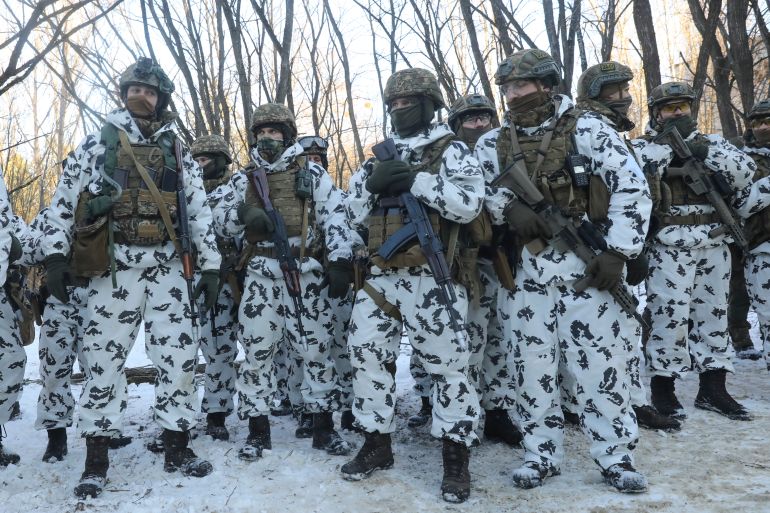Timeline: How did the recent Ukraine-Russia crisis start?
Months of diplomacy have failed to resolve the crisis, as fear grows over an imminent Russian invasion of Ukraine.

Tensions over the Ukraine-Russia crisis have been simmering for more than two months, with diplomatic efforts to resolve the issue showing little sign of progress.
Russia has more than 100,000 troops on its border with Ukraine, sparking Western warnings of an imminent invasion.
Keep reading
list of 3 itemsHow do Ukrainians in Russia feel about the crisis?
Americans should leave Ukraine within 48 hours, White House warns
Moscow, which has repeatedly denied it plans to invade and says it is responding to aggression by NATO allies, dismisses those warnings as “hysteria”.
Here is a timeline of the main events so far.
November 2021
Satellite imagery shows a new build-up of Russian troops on the border with Ukraine, and Kyiv says Moscow has mobilised 100,000 soldiers along with tanks and other military hardware.
December 7, 2021
US President Joe Biden warns Russia of sweeping Western economic sanctions if it invades Ukraine.
December 17, 2021
Russia presents detailed security demands to the West, including that NATO ceases all military activity in eastern Europe and Ukraine and that the alliance never accept Ukraine or other former Soviet nations as members.
January 3, 2022
Biden reassures Ukraine’s President Volodymyr Zelenskyy that the US will “respond decisively” if Russia invades Ukraine.
The two men spoke on the phone to discuss preparations for a series of upcoming diplomatic meetings to address the crisis.
January 10, 2022
US and Russian officials meet in Geneva for diplomatic talks but differences remain unresolved as Moscow repeats security demands that Washington says it cannot accept.
January 24, 2022
NATO puts forces on standby and reinforces its military presence in Eastern Europe with more ships and fighter jets. Some Western nations start evacuating non-essential embassy staff from Kyiv. The US puts 8,500 troops on alert.
January 26, 2022
Washington presents a written response to Russia’s security demands, repeating a commitment to NATO’s “open-door” policy while offering a “principled and pragmatic evaluation” of Moscow’s concerns.
January 27, 2022
Biden warns of a likely Russian invasion in February. China throws its political weight behind Russia and tells the US that Moscow’s “legitimate security concerns” should be “taken seriously”.
January 28, 2022
Russian President Vladimir Putin says Russia’s main security demands have not been addressed but that Moscow is ready to keep talking.
Ukraine’s President Zelenkskyy warns the West to avoid creating “panic” that will negatively affect his country’s economy.
January 31, 2022
US and Russia spar over the Ukraine crisis at a special closed session of the UN Security Council.
US Ambassador to the UN Linda Thomas-Greenfield told the council a Russian invasion of Ukraine would threaten global security.
Russia’s UN envoy Vasily Nebenzya accused Washington and its allies of drumming up the threat of war despite Moscow’s repeated denials of a planned invasion.
“The discussions about a threat of war is provocative in and of itself. You are almost calling for this. You want it to happen,” Nebenzya said.
February 1, 2022
Putin denies planning an invasion and accuses the US of ignoring his country’s security demands.
“It is already clear that fundamental Russian concerns ended up being ignored,” he said.
February 6, 2022
Russia has established 70 percent of the military buildup it needs to launch a full-scale invasion of Ukraine, according to American officials cited anonymously in US media.
February 8, 2022
French President Emmanuel Macron meets Putin for marathon talks in Moscow and tells reporters Russia will not escalate the Ukraine crisis.
However, the Kremlin denied that Macron and Putin struck a deal on de-escalating the crisis. Kremlin spokesman Dmitry Peskov said that “in the current situation, Moscow and Paris can’t be reaching any deals”.
February 10, 2022
UK Foreign Secretary Liz Truss and Russian FM Sergey Lavrov hold fruitless talks.
In an icy press conference, Lavrov described the meeting as “a conversation between a mute and a deaf person”.
He added that the “facts” presented by his team on the crisis “bounced off” their British counterparts.
Truss, who warned of tough Western sanctions if Ukraine was attacked, challenged Lavrov about his assertion that Russia’s buildup of troops and weaponry was not threatening anyone.
February 11, 2022
Biden’s national security adviser, Jake Sullivan, says US intelligence shows a Russian invasion could begin within days, before the Beijing Olympics end on February 20.
The Pentagon ordered an additional 3,000 US troops to be sent to Poland to reassure allies. Meanwhile, a number of countries called upon their citizens to leave Ukraine, with some warning that a military evacuation will not be guaranteed in the event of war.
February 12, 2022
Biden and Putin hold talks via video conference. The US president said a Russian invasion of Ukraine would cause “widespread human suffering” and that the West was committed to diplomacy to end the crisis but “equally prepared for other scenarios”.
Putin complained in the call that the US and NATO have not responded satisfactorily to Russian demands that Ukraine be prohibited from joining the military alliance and that NATO pull back forces from Eastern Europe.
Yuri Ushakov, Putin’s top foreign policy aide, said that while tensions have been escalating for months, in recent days “the situation has simply been brought to the point of absurdity”.
He said Biden mentioned the possible sanctions that could be imposed on Russia, but: “This issue was not the focus during a fairly long conversation with the Russian leader.”